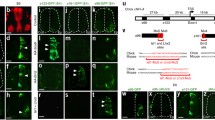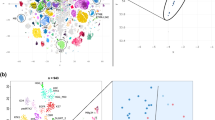Abstract.
Nkx6-2 (former Gtx) is a murine-homeobox-containing gene localized distally on Chromosome (Chr) 7. Analysis of the expression pattern, together with DNA binding assays, suggests that this gene product might be important for differentiated oligodendrocyte function and in the regulation of myelin gene expression. We now report on the cloning and characterization of the human homolog (NKX6B). DNA sequence analysis of an 11-kb genomic fragment revealed that the complete human gene spans 1.2 kb and is composed of three exons. NKX6B is predicted to encode a polypeptide of 277 amino acids with 97% identity to mouse Nkx6-2. Northern blot experiments showed that NKX6B expression is tightly controlled in a tissue-specific fashion with the highest site of expression being the brain. Finally, using STS content mapping and RH analyis, we demonstrated that NKX6B maps to the 10q26, a region where frequent loss of heterozygosity has been observed in various malignant brain tumors. These results may implicate NKX6B as a candidate tumor suppressor gene for brain tumors, particularly for oligodendrogliomas.
Similar content being viewed by others
Author information
Authors and Affiliations
Additional information
Received: 14 June 2000 / Accepted: 21 September 2000
Rights and permissions
About this article
Cite this article
Lee, SH., Davison, J., Vidal, S. et al. Cloning, expression and chromosomal location of NKX6B to 10q26, a region frequently deleted in brain tumors. 12, 157–162 (2001). https://doi.org/10.1007/s003350010247
Issue Date:
DOI: https://doi.org/10.1007/s003350010247




